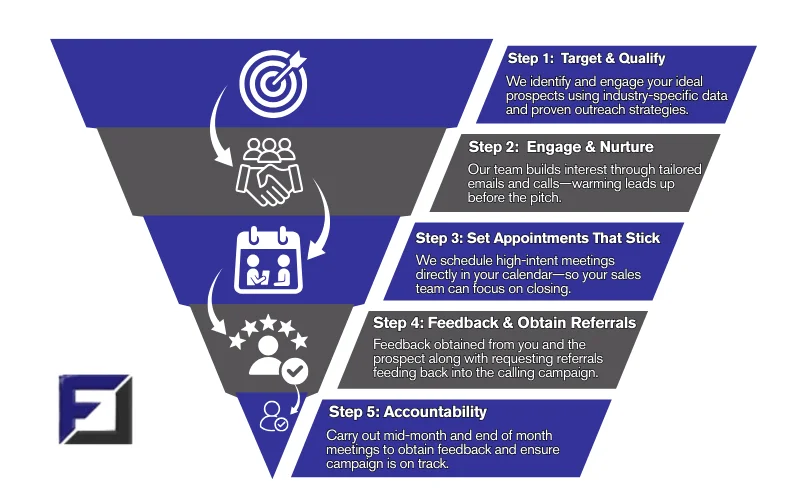B2B Appointment Setting Services
Work With Top Appointment Setters
Guaranteed SAT Meetings Or Your Money Back!
Trustindex verifies that the original source of the review is Google. Frontline Sales Consultancy has managed to deliver JH Security multiple sales opportunities through their appointment setting services and are a highly valued part of the JH Security sales process. I would highly recommend Frontline Sales Consultancy to any business looking to boost their sales pipeline.Trustindex verifies that the original source of the review is Google. Exceptional Service! We've been working with Frontline Sales Consultancy for the past few months, and the service has been beyond our expectations. As a training and coaching company, it’s essential for us to connect with the right decision-makers, and FLSC has consistently delivered high-quality appointments with precisely our target audience. Their professionalism, dedication, and effective communication make them stand out. We felt like FLSC was an extension of our own team, handling our outreach with the utmost care and detail. Their commitment to guaranteeing results is a rare and valuable asset in this industry. Highly recommend FLSC to any B2B company serious about scaling their pipeline with qualified meetings!"Trustindex verifies that the original source of the review is Google. We have been working closely with Frontline Sales Consultancy for the past 10 months and they have consistently delivered real results to help us secure new clients. The Frontline team has been a key strategic partner in helping PRN to expand by securing well qualified meetings with our target customers and I look forward to continuing to use Frontline Sales for the foreseeable future- PRN Cleaning ServicesTrustindex verifies that the original source of the review is Google. One word to describe Frontline Sales Guaranteed Sat Appointment Making Service…Deliver!!! They have managed to get me meetings with care home managers in the last 8 weeks & I have converted meetings to clients. Their approach is fantastic, and their customer service is great. I am using them every month. Tony and the team really are amazing!!! Director- Manny Bector – Sight Care At Home Your help in this matter is greatly appreciated. Thanks Manny 😊Trustindex verifies that the original source of the review is Google. As a software development company, reaching decision-makers can be tough, but Frontline Sales Consultancy have made a noticeable difference in our outreach. Their telemarketing team has been incredibly effective at connecting us with key decision-makers. They've taken the time to really get what we do, and it shows in the way they engage the prospects. Their professionalism and persistence have helped us expand our client base. Highly recommended, would continue to hire them again.Trustindex verifies that the original source of the review is Google. Working with Frontline Sales Consultancy has been a game-changer for me. We were initially hesitant about outsourcing B2B appointment setting, but they’ve completely exceeded our expectations. The leads we’re getting are high-quality, and it’s clear they took the time to understand our specific needs. Their team is incredibly communicative, keeping us updated regularly, and they deliver results fast. Since partnering with them, we've seen a noticeable boost in our sales pipeline. Highly recommended!Trustindex verifies that the original source of the review is Google. “I have been using Frontline Sales Consultancy for the past 12 months, and their Guaranteed SAT Business to Business appointment-making service has exceeded all my expectations. Over the last year, they have secured 60 meetings for Directions Healthcare, and I have successfully converted 40 of those meetings into clients. Their commitment to delivering results, backed by a money-back guarantee, has been instrumental in growing my business. The team at Frontline has consistently delivered high-quality appointments with decision-makers, and I couldn’t be happier with the service. I highly recommend them to any business looking to expand its client base!” Kevin - directions HealthcareTrustindex verifies that the original source of the review is Google. “I used the Guaranteed Sat Appointment Making Service from Frontline Sales and they generated well qualified meetings with Care Home Managers who were interested in my service. Tony and his team also Sat the meeting on my behalf and converted opportunities into clients. I am now supplying staff into these Care homes and I wouldn’t be dealing with these homes if it wasn’t for Frontline Sales. They delivered above and beyond my expectations. I couldn’t be happier. Thank you Frontline Sales” Rapid Healthcare – Wellington MatsivoTrustindex verifies that the original source of the review is Google. “We have been using Frontline Sales Consultancy for over 2 years and they have consistently delivered on results. They have successfully gotten us on numerous sites for a number of construction companies and are a key strategic arm of South East Fire and Security. Would highly recommend Frontline Sales Consultancy and their guaranteed sat appointment making service.”Verified by TrustindexTrustindex verified badge is the Universal Symbol of Trust. Only the greatest companies can get the verified badge who has a review score above 4.5, based on customer reviews over the past 12 months. Read more
What is Appointment Setting?
The sales process revolves mostly on appointment setting particularly in business-to-business sectors. It’s all about scheduling appointments between a potential client and a salesperson; simple as that. Still, you should not underestimate it; it is more than just scheduling a time window.
At these meetings businesses have the opportunity to present their offerings, learn what the customer wants, and—finally—move them closer to a purchase.
Consider it as the link between a first spark of curiosity and a meaningful conversation. When done correctly, it allows companies to maintain their sales funnels and build lasting relationships.

UK-Wide B2B Appointment Setting Services
At Frontline Sales Consultancy, we recognise that having a full appointment schedule isn’t enough; those leads must be qualified. Many B2B organisations send leads to their sales teams without first determining if they are ready to purchase – we do things differently.
Our strategy focuses on developing connections and nurturing leads. We put your salespeople in front of the right prospects. Appointment setting companies play a crucial role in facilitating the scheduling of meetings and converting prospects into highly qualified leads. Face-to-face interactions are still quite effective, particularly for high-value transactions.
With our B2B Lead Generation And Appointment Setting Services, your team will meet with the right individuals and complete those important contracts.
Core Features of B2B Appointment Setting
Following Up with New Business Leads
Following up on fresh business leads ensures that prospects remain interested. Our staff follows up with prospective customers on a frequent basis to keep their attention and guide them through the buying process.
This constant contact helps to turn leads into valuable, long-term business connections.
Telephone Lead Generation
Telephone lead generation is still an efficient approach to engaging with prospects. Our staff outreach via emails and make targeted calls to discover quality leads, establish connections, and schedule meetings with decision-makers.
This personal approach facilitates direct connection and builds trust between your company and prospective customers.
Online Demos or Webinars
Online demonstrations and webinars are effective ways to showcase your goods or services. Our staff organises these meetings with qualified prospects, enabling you to demonstrate solutions in real-time.
This collaborative method fosters trust and speeds decision-making, converting leads into customers.
Up-sell or Cross-Sell Activities
During appointments, our staff looks for chances to upsell and cross-sell.
We analyse your client’s business needs and offer new items or services that complement their existing purchases, allowing you to increase income while deepening customer relationships via tailored suggestions.
Membership or Subscription Renewal
Our staff helps manage memberships and subscription renewals by proactively reaching out to customers before their contracts expire. This ensures prompt renewals, lowers churn, and develops long-term connections, allowing your organisation to generate consistent, recurring revenue while keeping consumers engaged and satisfied.
Why is B2B Appointment Setting Essential for Your Business?
Builds Stronger Client Relationships
Setting up B2B appointments gives your prospects chances for actual, one-on-one meetings. These tailored dialogues foster trust, help you better grasp their demands, and demonstrate how your solution solves their problem.
This strategy helps connections grow over time, transforming potential customers into long-term partners who appreciate your company and the assistance you provide.
Saves Time for Your Sales Team
B2B Sales Appointment Setting Services removes pressure on your sales staff by managing the time-consuming chore of scheduling meetings. Your staff can concentrate on what they excel at—closing deals—instead of following leads.
This streamlined strategy not only increases productivity but also makes sure that more energy is used to build connections with the most important prospects.
Ensures Targeted Prospect Engagement
B2B appointment setting ensures your outreach reaches the appropriate individuals at the appropriate moment. Focussing on prospects who fit your ideal client profile helps you to reduce wasted effort and raise the possibility of meaningful conversations.
This tailored approach not only draws interest but also fosters trust, which makes it easier to turn leads into long-term customers.
Increases Conversion Rates
By concentrating on qualified prospects and organising engaging conversations, the B2B appointment setting helps turn leads into loyal customers.
Businesses may establish confidence and trust by understanding customer requirements and presenting solutions at the proper moment. This focused, individual approach makes it simpler to move prospects through the sales process and close more deals.
Boosts Sales Pipeline Efficiency
B2B appointment scheduling keeps your sales flow unbroken. By matching the appropriate prospects with salespeople to schedule important appointments, it saves time and directs your efforts where they most count. Your company can gain a significant advantage in a competitive market by using this focused strategy to enable salespeople to work smarter, create connections quicker, and complete transactions more effectively.
Our Services
Streamline your outreach with our B2B appointment setting services. We book high-quality meetings with key decision-makers for your business growth.
Boost your sales with our expert B2B lead generation services. Targeted strategies to connect you with potential clients and drive growth.
Enhance your business with our B2B telemarketing services. Our Expert agents connect you with key decision-makers to drive sales and growth.
Ready to Connect with Decision-Makers?
Setting high quality appointments is a great way to attract more customers. This is the first stage of many sales processes, and it helps companies get in touch with senior decision makers. However, managing it yourself can be expensive and time-consuming.
We are here to help with that – if you are looking for reliable appointment setters, then Frontline Sales Consultancy is what you need. Our seasoned appointment setters know how to handle leads, build relationships, and turn prospects into sales.
Whether you work in finance, healthcare, or another field, we will help you set qualified meetings with key decision-makers of businesses that suit your industry.

Reasons to Choose B2B Outsourced Appointment Setting Services
Cost Efficiency
Outsourcing appointment scheduling could help you save money. Instead of recruiting and training an in-house staff, you receive competent individuals who are ready to go.
In this sense, you guarantee excellent appointments while avoiding additional expenses such as staff, office space, and technology (software tools).
Access to Expertise
Outsourcing allows you to tap into the expertise of our appointment setters, who are already familiar with your industry.
They know how to qualify leads and create relationships, increasing your chances of success – you won’t need to train your own staff.
Increased Reach
Outsourcing helps you to enter new markets and locations that may be difficult to reach on your own.
Our dedicated staff will help you expand your reach, you will be able to interact with more prospects and decision makers from a larger geographic region.
Focus on Core Business Activities
By outsourcing appointment setting to FLSC, your staff can focus solely on their areas of greatest expertise.
Such as completing transactions, creating products, and expanding the company instead of wasting time looking for prospects – they can leave the appointment setting to the professionals.
Scalability
An outsourced appointment setter service makes it easy to increase or decrease the number of meetings to suit your appointment setting needs.
You can get more leads when things are busy or fewer leads when things are slow – this gives you control without overcommitting resources.
Better Lead Qualification Process
Outsourced teams concentrate on discovering high-quality leads.
They guarantee that every meeting is with a prospect who matches your target market, so your sales force can spend less time chasing unqualified leads and more time closing agreements with the right individuals.

Boost Your Lead Generation with B2B Appointment Setting Service:
As a leading UK based B2B Appointment Setting Agency, we don’t just stop at generating high-quality leads—we also offer expert sales appointment setting services to ensure your sales team focuses on what matters.
By outsourcing your appointment setting to us, you’ll have a steady flow of qualified sales leads while your key salespeople concentrate on building relationships and closing deals.
Our clients love how we seamlessly handle both b2b lead generation and appointment setting, making their sales process smoother and more effective. Let us help you nurture your b2b sales pipeline and boost your business growth.
Proven Techniques for Successful B2B Appointment Setting
Identify and Engage the Right Prospects:
Knowing who to target determines whether a B2B appointment setting campaign is successful. Researching and spotting candidates who fit your desired customer profile helps you to concentrate your efforts where they will be most beneficial.
Once you have identified the appropriate prospects, tailored outreach helps draw their attention, start important dialogues, and create bonds that result in strong business partnerships.
Adopt a Multi-Channel Outreach Strategy:
By contacting prospects via multiple channels—such as email, phone calls, and LinkedIn—you increase your chances of making a connection. A well-thought-out approach keeps your company visible without overloading potential customers.
Give prospects time to process your communications, then follow up with valuable material. Combining platforms shows adaptability, develops rapport, and raises the possibility of meaningful engagement.
Harness the Power of Personalisation:
Personalisation is key to effective B2B appointment setting; you show you have done your research by customising your approach to every prospect—using their name, job title, business facts, or even citing their current successes.
This careful approach helps you to establish confidence and makes your outreach stand out. Prospects that feel understood and respected are significantly more inclined to participate, which improves the outcomes.
Leverage Advanced Tools and Technology Effectively:
Appropriate tools can help to streamline and expedite appointment setting. Scheduling software and CRM systems save team time by automating follow-ups, tracking prospects, managing meetings.
Calendly or HubSpot tools guarantee no lead slips pass through the cracks. Keeping the procedures structured and streamlined can help your staff concentrate on strengthening relationships and closing more deals.

How to Tackle B2B Appointment-Setting Challenges?
Handling Gatekeepers and Addressing Objections:
Gatekeepers are people rather than obstacles – respect them, and they will probably be of help to you. Clearly, politely, and with confidence explain why you are calling. When problems surface, pay close attention and answer thoughtfully.
Show how your solution helps their company to address problems. A calm, collected, professional attitude can convert objections into a chance to start important conversations.
Minimising No-Shows and Managing Cancellations:
Though missed appointments might be annoying, reminders really help. Before the meeting, send courteous follow-ups stressing the significance of the conversation. If there are any cancellations, be adaptable and suggest rescheduling at a time more convenient for them.
Demonstrating professionalism and understanding helps to maintain a good relationship and raises the likelihood of them staying engaged and giving future appointments a top priority.


Standing Out in a Competitive Market:
Making your firm stand out in a congested market is really crucial. Emphasise your own abilities and concentrate on what distinguishes you. Personalised outreach and straightforward communication can capture attention while showing how your ideas address certain issues and foster confidence.
Offering actual value and building sincere relationships can help you create a lasting impression that keeps your company ahead of its rivals.
What Happens When You Outsource Appointment Setting Services?
We take care of all the details when you outsource appointment scheduling so your sales staff meets with the right individuals. We only schedule meetings with decision makers with the power to make purchases; we ensure prospects have the budget to buy.
We also make sure your products and services fit the prospect and assess their purchasing schedule so your staff meets qualified leads who are genuinely interested and are ready to buy. This ensures that your sales process goes smoothly and effectively.


Our Team of Professional Appointment Setters:
Having an internet presence is beneficial, but it is not enough if you want to truly connect with prospective customers. Our dedicated team of professional appointment setters helps you go beyond just being visible; they build genuine, meaningful connections with decision-makers in your market.
As a top-tier Appointment Setting Firm, we don’t only arrange meetings. We focus on building relationships that lead to mutually beneficial transactions. Whether on LinkedIn or other business networks, our staff guarantees that you not only connect with prospects but also create long-term, trustworthy partnerships in your industry.
FAQs
An appointment setter’s role is to arrange demos or calls to convert prospects into warm leads. Strong communication and persuasive skills enable them to convince potential customers to schedule a meeting, therefore enabling businesses to increase their sales and customer base.
Businesses depend on quality appointments as they guarantee a consistent supply of quality leads. The presence of a professional appointment setter ensures that your calendar is consistently filled with qualified leads who are eager to interact. This lets your sales staff concentrate on completing transactions, thus increasing efficiency and growth.
Your appointment count can be increased easily through outsourcing. You can rely on a committed team of experts rather than answering calls yourself or recruiting new staff. Our skilled appointment setters are dedicated to filling your schedule with quality leads, saving you time and enhancing your sales opportunities.
Qualified appointments help companies of all kinds. Qualified leads acquired by sales teams save time and free them to concentrate on closing deals. Small businesses can quickly get in touch with important decision-makers, and big businesses can speed up the sales process. In the end, more focused and efficient interactions help both the company and its customers.
In marketing, a “gatekeeper” is the person in charge of managing access to a company’s decision-maker. Usually serving as gatekeepers, receptionists or assistants, they sort calls and emails to determine who passes through. The ability to successfully navigate gatekeepers is critical for reaching important people who make purchase choices.
In marketing, gatekeepers act to protect decision-makers from receiving unsolicited calls and ensure their time isn’t wasted. They filter out unnecessary contacts, making it tough to reach key individuals. Our speciality lies in convincing these gatekeepers that our calls are valuable, allowing us to connect you with important contacts for your business growth. As one of the Best Appointment Setting Companies in the UK, we excel at getting past any gatekeeper to reach the decision-makers you need by building rapport and connecting with them.
On the first call, pitching for a sale might sound overly pushy and off-putting. It is more effective to pique the prospect’s interest before setting up a follow-up appointment. This strategy allows you time to understand their specific company requirements, thereby facilitating a more successful sales conversation later on.
A day or two after a meeting, we send a message to thank the client for their time and answer any questions they may have. A few days later, we follow up once again to see if they are ready to make decisions or whether they need another discussion to go over more details.



